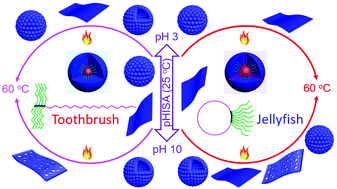Multi-tunable aggregation behaviors of thermo/pH-responsive toothbrush-like and jellyfish-like copolymers†
Abstract
The combination of cyclic and linear segments provides a promising opportunity for the construction of polymeric materials with intriguing physical properties. This study aims at the design of comb-like-linear diblock copolymers to achieve thermoresponsive and aggregation properties relying on topology, composition and stimuli. Toothbrush-like and jellyfish-like copolymers with poly(2-(dimethylamino)ethyl methacrylate) grafts tethered to a linear or cyclic polyacrylate-block-poly(N-isopopylacrylamide) backbone are synthesized, and the analogues with relatively short pendant chains can exhibit a pronounced topology effect. Variable nanostructures involving spheres, vesicles, lamellae and porous lamellae can be sequentially formed during thermo/pH-induced self-assembly. Owing to topological constraints and enhanced interactions between side chains and the backbone, the cyclic architecture can play a crucial role in self-assembly, as evidenced by the distinct order of morphological transitions and improved stability of lamellar nanostructures against acid and heat. Bicomponent comb-like-linear copolymers can hold great promise in the construction of topology-dependent hierarchical self-assembly platforms.



 Please wait while we load your content...
Please wait while we load your content...